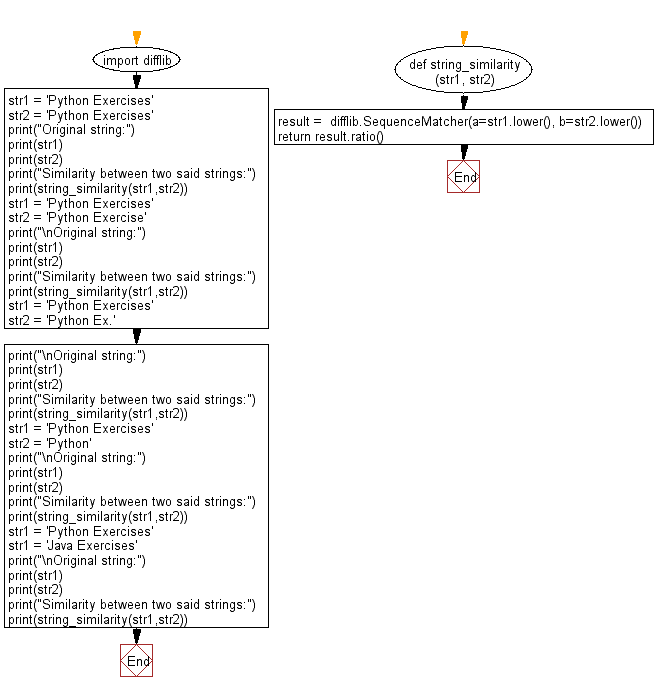Python: Find the string similarity between two given strings
Find similarity between two strings.
Write a Python program to find string similarity between two given strings.
From Wikipedia:
In computer science, approximate string matching (often colloquially referred to as fuzzy string searching) is the technique of finding strings that match a pattern approximately (rather than exactly).
Sample Solution:
Python Code:
# Import the difflib module for computing string similarity
import difflib
# Define a function to calculate the similarity ratio between two strings
def string_similarity(str1, str2):
# Create a SequenceMatcher object with the lowercase versions of the input strings
result = difflib.SequenceMatcher(a=str1.lower(), b=str2.lower())
# Return the similarity ratio between the two strings
return result.ratio()
# Initialize two strings for comparison
str1 = 'Python Exercises'
str2 = 'Python Exercises'
# Print the original strings
print("Original string:")
print(str1)
print(str2)
# Print a message indicating the similarity between the two strings
print("Similarity between two said strings:")
print(string_similarity(str1, str2))
# Repeat the process with different pairs of strings
str1 = 'Python Exercises'
str2 = 'Python Exercise'
print("\nOriginal string:")
print(str1)
print(str2)
print("Similarity between two said strings:")
print(string_similarity(str1, str2))
str1 = 'Python Exercises'
str2 = 'Python Ex.'
print("\nOriginal string:")
print(str1)
print(str2)
print("Similarity between two said strings:")
print(string_similarity(str1, str2))
str1 = 'Python Exercises'
str2 = 'Python'
print("\nOriginal string:")
print(str1)
print(str2)
print("Similarity between two said strings:")
print(string_similarity(str1, str2))
str1 = 'Python Exercises'
str2 = 'Java Exercises'
print("\nOriginal string:")
print(str1)
print(str2)
print("Similarity between two said strings:")
print(string_similarity(str1, str2))
Sample Output:
Original string: Python Exercises Python Exercises Similarity between two said strings: 1.0 Original string: Python Exercises Python Exercise Similarity between two said strings: 0.967741935483871 Original string: Python Exercises Python Ex. Similarity between two said strings: 0.6923076923076923 Original string: Python Exercises Python Similarity between two said strings: 0.5454545454545454 Original string: Java Exercises Python Similarity between two said strings: 0.0
Flowchart:

For more Practice: Solve these Related Problems:
- Write a Python program to calculate the similarity ratio between two strings using the SequenceMatcher from difflib.
- Write a Python program to implement a function that returns a similarity score between 0 and 1 for two input strings.
- Write a Python program to compare two strings and output their similarity percentage based on matching characters and order.
- Write a Python program to use a custom algorithm to compute the edit distance and derive a similarity metric between two strings.
Go to:
Previous: Write a Python program to convert a given heterogeneous list of scalars into a string.
Next: Write a Python program to extract numbers from a given string.
Python Code Editor:
What is the difficulty level of this exercise?
Test your Programming skills with w3resource's quiz.
